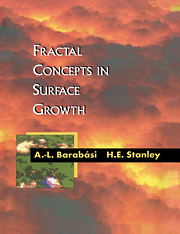Book contents
- Frontmatter
- Contents
- Preface
- Notation guide
- PART 1 Introduction
- PART 2 Nonequilibrium roughening
- PART 3 Interfaces in random media
- 9 Basic phenomena
- 10 Quenched noise
- 11 Experiments
- PART 4 Molecular beam epitaxy
- PART 5 Noise
- PART 6 Advanced topics
- PART 7 Finale
- APPENDIX A Numerical recipes
- APPENDIX B Dynamic renormalization group
- APPENDIX C Hamiltonian description
- Bibliography
- Index
10 - Quenched noise
Published online by Cambridge University Press: 23 December 2009
- Frontmatter
- Contents
- Preface
- Notation guide
- PART 1 Introduction
- PART 2 Nonequilibrium roughening
- PART 3 Interfaces in random media
- 9 Basic phenomena
- 10 Quenched noise
- 11 Experiments
- PART 4 Molecular beam epitaxy
- PART 5 Noise
- PART 6 Advanced topics
- PART 7 Finale
- APPENDIX A Numerical recipes
- APPENDIX B Dynamic renormalization group
- APPENDIX C Hamiltonian description
- Bibliography
- Index
Summary
The goal of understanding the effect of quenched noise on interface morphology has motivated a large number of numerical studies. Several models have been developed, both for understanding specific phenomena such as fluid flow or domain growth, and also for the efficient determination of the scaling exponents. In general, it is agreed that quenched noise produces anomalous roughening, with a roughness exponent larger than the values predicted by the KPZ or EW equations.
We can partition the numerical efforts in two distinct classes, according to the morphology of the interface.
(i) There is a family of models that neglects overhangs on the interface, by proposing a growth rule that produces self-affine interfaces. In some of these models, the scaling exponents can be obtained exactly by mapping the interface at the depinning transition onto a directed percolation problem.
(ii) There is a second family of models that allows overhangs, often leading to self-similar interfaces. In some cases, the interface generated by these models can be mapped onto a site percolation problem, and the scaling exponents can be estimated by exploiting this mapping.
Moreover, models leading to self-affine interfaces can also be classified in two main universality classes. As we show, the two classes have different scaling exponents, which can be obtained using numerical and analytical methods.
- Type
- Chapter
- Information
- Fractal Concepts in Surface Growth , pp. 99 - 114Publisher: Cambridge University PressPrint publication year: 1995



